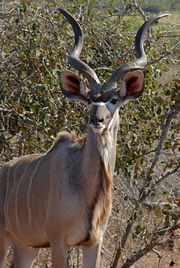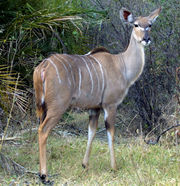Greater Kudu
| Greater Kudu | |
|---|---|
 |
|
| Greater Kudu bull | |
.jpg) |
|
| Female | |
| Conservation status | |
| Scientific classification | |
| Kingdom: | Animalia |
| Phylum: | Chordata |
| Class: | Mammalia |
| Order: | Artiodactyla |
| Family: | Bovidae |
| Subfamily: | Bovinae |
| Genus: | Tragelaphus |
| Species: | T. strepsiceros |
| Binomial name | |
| Tragelaphus strepsiceros (Pallas, 1766) |
|
The Greater Kudu (Tragelaphus strepsiceros) is a woodland antelope found throughout eastern and southern Africa. Despite occupying such widespread territory, they are sparsely populated in most areas, due to a declining habitat, deforestation and hunting.[2]
Contents |
Physical characteristics

They have a narrow body with long legs, and their coats can range from brown/bluish-grey to reddish-brown. They possess between 4–12 vertical white stripes along their torso. The head tends to be darker in colour than the rest of the body, and exhibits a small white chevron which runs between the eyes.[2]
Male Greater Kudus tend to be much larger than the females, and vocalize much more, utilizing low grunts, clucks, humming, and gasping. The males also have large manes running along their throats, and large horns with two and a half twists, which, were they to be straightened, would reach a length of 1 metre on average. However, the male horns do not begin to grow until the male is between the age of 6–12 months, twisting once at around 2 years of age, and not reaching the full two and a half twist until they are 6 years old.[2]
Males weigh 190-270 kg (419-595 lbs) while females weigh 120-210 kg (265-463 lbs). Females do not have horns while the bulls have horns that average 120 cm (42 in) in length with the record being 187.64 cm (73.87 in).[2]
Subspecies
Formerly four subspecies have been described, but recently only one to three subspecies have been accepted based on colour, number of stripes and horn length[3]:
- T. s. strepsiceros, southern parts of the range from southern Kenya to Namibia, Botswana and South Africa
- T. s. chora, northeastern Africa from northern Kenya through Ethiopia to eastern Sudan, western Somalia and Eritrea
- T. s. cottoni, Chad and western Sudan
This classification was supported by the genetic difference of one specimen of northern Kenya (T. s. chora) in comparison with several samples from the southern part of the range between Tanzania and Zimbabwe (T. s. strepsiceros). No specimen of the northwestern population, which may represent a third subspecies (T. s. cottoni) was tested within this study[3].
Lifestyle
The range of the Greater Kudu extends from the east in Ethiopia, Tanzania, Eritrea and Kenya into the south where they are found in Zambia, Angola, Namibia, Botswana, Zimbabwe and South Africa. They have also been introduced in small numbers into New Mexico. Their habitat includes thick bushveld, rocky hillsides, dry riverbeds and anywhere with a constant supply of water. They will occasionally venture onto plains only if there is a large abundance of bushes, but normally avoid such open areas to avoid becoming an easy target for their predators. Their diet consists of leaves, grass, shoots and occasionally tubers, roots and fruit (they are especially fond of oranges and tangerines).[2]
During the day, Greater Kudus normally cease to be active and instead seek cover under woodland, especially during hot days. They feed and drink in the early morning and late afternoon, acquiring water from waterholes or roots and bulbs which have a high water content. Although they tend to stay in one area, the Greater Kudu may search over a large distance for water in times of drought, in southern Namibia where water is relatively scarce they have been known to travel extremely long distances in very short periods of time.[2]
Predators
Predators of the greater kudu generally consist of lions, leopards and hunting dogs. Although cheetahs also prey on greater kudus, they are unable to bring down a mature male, so usually go for the more vulnerable females and offspring. When a herd is threatened by predators, an adult (usually female) will issue a bark to alert the rest of the herd. Despite being very nimble over rocky hillsides and mountains, the greater kudu is not fast enough (and nor does it have enough stamina) to escape its main predators over open terrain, so instead relies on leaping over shrubs and small trees to shake off pursuers.[2]
Social system
Female greater kudus live in small herds of six to twenty individuals along with their calves, though males tend to be mainly solitary, they sometimes form bachelor herds that consist of 4 to 8 young males (sometimes with an older bull as well). Rarely will a herd reach a size of forty individuals, partly because of the selective nature of their diet which would make foraging for food difficult in large groups.[2] A herd's area can encompass 800 to 1,500 acres (6.1 km2), and spend an average of 54% of the day foraging for food..
Fully mature males will often fight other males by interlocking their horns with the other until one of them admits defeat and gives in. In rare circumstances this can sometimes result in both males being unable to free themselves from the other's horns, usually resulting in the death of both animals. Females may sometimes ward off males by biting them, due to their lack of horns.[2]
Reproduction

Greater kudus reach sexual maturity between 1–3 years of age. The mating season occurs at the end of the rainy season, which can fluctuate slightly according to the region and climate. Before mating, there is a courtship ritual which consists of the male standing in front of the female and often engaging in a neck wrestle. The male then trails the female while issuing a low pitched call until the female allows him to copulate with her. Gestation takes around 240 days (or eight months).[2] Calving generally starts between February and March, when the grass tends to be at its highest.
Offspring and maternal care
Greater kudus tend to bear one calf, although occasionally there may be two. To begin with, the calf will wait for the mother to feed it, but later it will become more demanding in its search for milk, and after a few months even aggressive.[2] For the first two weeks of a calf's life they hide where predators cannot find them. For four to five weeks after that they roam with the herd only during day. Males will become self-sufficient at 6 months old. Females become self-sufficient at around 1 to 2 years old. Greater kudus may live up to 20 years of age when kept in captivity.[2]
Human interaction
Greater kudus have both benefited and suffered from interaction with humans; they are a target for hunters, possibly due to their habit of stopping to look behind them after bolting for cover, making them an easy target. Humans have also destroyed woodland cover which they use for their habitat. However, wells and irrigation set up by humans has also allowed the greater kudus to occupy territory which would have been too devoid of water for them previously.[2]
The horns of greater kudus are commonly used to make Shofars, a Jewish ritual horn blown at Rosh Hashanah.
See also
- Lesser Kudu
- Kudu dung spitting
References
- ↑ IUCN SSC Antelope Specialist Group (2008). Tragelaphus strepsiceros. In: IUCN 2008. IUCN Red List of Threatened Species. Downloaded on 29 March 2009. Database entry includes a brief justification of why this species is of least concern.
- ↑ 2.00 2.01 2.02 2.03 2.04 2.05 2.06 2.07 2.08 2.09 2.10 2.11 2.12 Wildlife Fact File. IMP Publishing Ltd. 1994. Group 1, Card 110. ISBN 08-50-04-0016.
- ↑ 3.0 3.1 LOUISE GRAU NERSTING and PETER ARCTANDER: Phylogeography and conservation of impala and greater kudu. Molecular Ecology (2001) 10 , 711–719 online
External links
|
||||||||||||||||||||||||||||||||||||||||||||||||||||||||||||||||||||||||||||||||||||||||||||||||||||||||||||||||||||||||||||||||||||||||||||||||||||||||||||||||||||||||||||||||||||||||||||||||||||||||||||||||||||||||||||||||||||||||||||||||||||||||||||||||||||||||||||||||||||||||||||||||||||||||||||||||||||||||||||||||||||||||||||||||||||||||||||||||||||||||||||||||||||||||||||||||||||